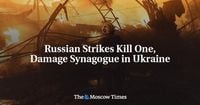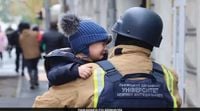On October 22, 2025, Ukraine awoke to the echo of explosions and the flicker of emergency lights, as Russia unleashed a sweeping barrage across the country. Power plants, civilian infrastructure, and a kindergarten in Kharkiv were among the targets, leaving at least six dead, dozens injured, and entire regions plunged into darkness. The timing of the attack—just hours after U.S. President Donald Trump postponed a much-anticipated summit with Russian President Vladimir Putin—underscored the volatile intersection of warfare and diplomacy now gripping Eastern Europe.
According to The New York Times, the kindergarten strike in Kharkiv’s Kholodnohirskyi district occurred around 11 a.m. local time. Three drones slammed into the building, igniting a fire that sent thick smoke billowing into the autumn sky. Emergency crews rushed to the scene, rescuing children from an underground shelter where all 48 had been moved after air raid sirens sounded. Miraculously, no children were injured, but a passerby lost their life and nine others were wounded. The city’s parents, clutching their children close, fled the burning building as the second floor collapsed—a scene captured in a video shared by President Volodymyr Zelensky and widely circulated by BBC and other outlets.
"Russia continues to do everything it can to weasel out of diplomacy," Zelensky said in a televised address, as reported by Bloomberg. "As soon as the issue of long-range capabilities for us, for Ukraine, became less immediate, Russia’s interest in diplomacy faded almost automatically." The Ukrainian president’s frustration was palpable. Just days earlier, he had returned from Washington, where he’d sought to persuade Trump to supply American long-range missiles—a plea that ended without success.
The attacks on October 22 were not limited to Kharkiv. Russian missiles and drones struck power plants and civilian sites across Ukraine, forcing Kyiv to impose emergency electricity restrictions for both households and industry. Over 140,000 residents in the Chernihiv region alone lost power, with blackouts spreading to Zaporizhzhia, Dnipropetrovsk, Kirovohrad, Poltava, Sumy, and Odesa oblasts. The country’s energy ministry accused Moscow of employing "double-tap" tactics—striking a facility, then hitting it again when repair crews arrived. The result has been catastrophic: approximately 60 percent of Ukraine’s natural gas production was destroyed, leaving the nation facing nationwide blackouts and a $2.6 billion bill for imported fuel this winter, according to Bloomberg.
The broader context is no less grim. The Russian barrage followed a familiar pattern: major attacks after significant moments in U.S.-Russia diplomacy. The Trump administration’s decision to postpone the Budapest summit came after Russian officials refused to budge on their maximalist demands, rejecting a cease-fire proposal that would freeze the current front lines. Moscow instead insisted on full control of all of Donetsk Oblast and a ban on NATO troops in Ukraine—terms Kyiv and its allies dismissed as nonstarters.
Ukrainian officials and analysts have grown wary of what they see as Putin’s strategy of using high-profile meetings to buy time and avoid consequences. Mykhailo Samus, director of the New Geopolitics Research Network in Kyiv, told The New York Times, “Trump realized that this meeting would be a catastrophe, and he would gain nothing but shame. But the question is, what is next? Will Putin be able to get him to such a meeting again?”
As peace talks stalled, Russia conducted nuclear weapons drills, including test launches of intercontinental ballistic missiles, in a move widely seen as both training and strategic messaging. Meanwhile, the front lines in eastern Ukraine remained fluid and fiercely contested. Russian forces claimed the capture of three villages—Pryvillia in Dnipropetrovsk region, and Pishchane and Tykhe in Kharkiv region. Kyiv disputed some of these losses, reporting that most attacks in the Tykhe area were repelled. President Putin boasted of seizing nearly 5,000 km² of Ukrainian territory in 2025, though independent analysts, including the Institute for the Study of War, cautioned that the figure is likely inflated.
On the ground, the fighting has become a slugfest. Ukrainian troops emphasize counter-offensive probes and layered defenses, especially around Kupyansk in northeastern Kharkiv, where authorities have ordered the evacuation of hundreds of families amid sustained Russian pressure. Russia’s strategy appears focused on incremental advances and fortification rather than sweeping maneuvers, relying heavily on artillery, drones, and attritional warfare.
Ukraine, for its part, has intensified its own campaign deep inside Russia. Long-range drones have struck key munitions and naval fuel infrastructure, including the Bryansk Chemical Plant and the Orenburg gas processing facility operated by Gazprom, forcing shutdowns that threaten to undermine Moscow’s war economy. Ukrainian officials confirmed that upgraded Sea Baby drones, capable of traveling 1,500 km while carrying two tons of explosives, have targeted the Crimean bridge supports—a critical supply line to the occupied peninsula.
Amid the violence, Ukraine’s quest for Western support has taken on new urgency. European nations have stepped up as primary backers since Washington halted direct military aid. On October 22, President Zelensky signed a letter of intent in Linköping to acquire up to 100-150 Swedish JAS 39 Gripen-E fighter jets—a deal that, while not guaranteeing immediate deliveries, signals deepening air-force cooperation. Ukraine expects the first Gripens to arrive in 2026. Meanwhile, Belgium announced it would supply F-16 fighters within 12-18 months, contingent on NATO air defense upgrades, and Germany pledged more than $2 billion in military aid, including air-defense systems, interceptor missiles, and radar equipment.
Norway, too, has pledged $140 million for Ukrainian energy support, as Zelensky embarks on a Nordic tour to rally further assistance. Yet, despite these commitments, the pace of Western military aid has slowed: the Kiel Institute noted a 43 percent drop in July–August 2025 compared to earlier months.
Political maneuvering continues to complicate hopes for a negotiated settlement. Trump’s proposal to freeze the war at current front lines was described by Zelensky as “a good compromise,” but few in Kyiv believe Moscow will accept it. Instead, Russia’s demand for full control of the Donbas and its withdrawal from the scheduled summit have left the peace process in limbo.
For ordinary Ukrainians, the cost is measured not in diplomatic communiqués but in lives and livelihoods. The attack on the Kharkiv kindergarten, which Zelensky described as “deliberate killing of children,” has become a symbol of the war’s relentless toll on the innocent. As winter approaches and the lights flicker across Ukraine, the nation braces for more hardship—and waits to see whether the world’s leaders can muster the pressure needed to bring the violence to an end.

